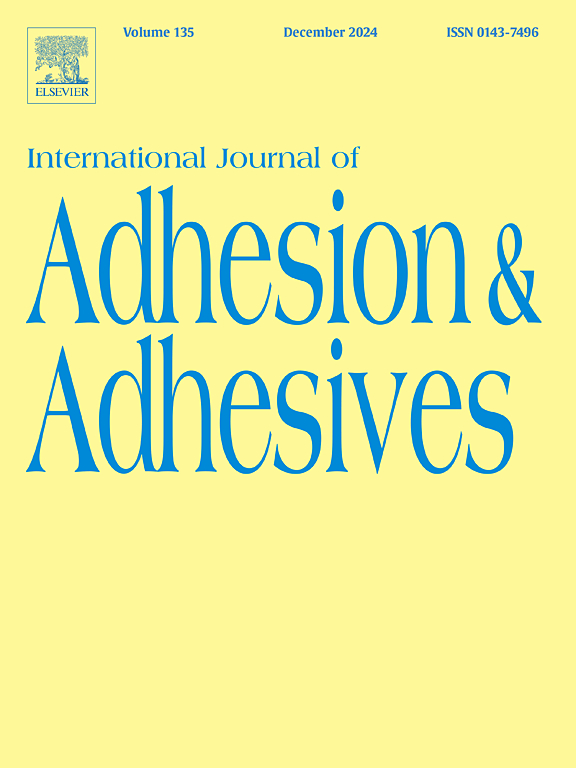Effect of reaction layer removal methods on bond strength of pressed lithium disilicate ceramic to resin cement
IF 3.2
3区 材料科学
Q2 ENGINEERING, CHEMICAL
International Journal of Adhesion and Adhesives
Pub Date : 2025-03-26
DOI:10.1016/j.ijadhadh.2025.104018
引用次数: 0
Abstract
The aim of this study was to evaluate the impact of reaction layer removal methods on the immediate and long-term bond strength of pressed lithium disilicate ceramics, with or without 5% hydrofluoric acid (HF) etching. For this, sixty lithium disilicate ceramic discs (Ø= 12 mm, thickness= 1.2 mm) were assigned to 6 groups based on removal method and surface pretreatment: CTRL (polishing only), CTRL + HF (polishing + HF etching), GB (grit-blasting), GB + HF (grit-blasting + HF), LCA (grit-blasting + 0.6% HF + 1.7% H2SO4), and LCA + HF (LCA + HF). Resin cement cylinders were built, light-cured, and tested for microshear bond strength (μSBS) after 24 h or 90 days (with 10,000 thermal cycles). Surface topography, chemical composition, and failure modes were assessed. No significant difference in bond strength was observed between groups at baseline (p> 0.05). After aging, LCA + HF and GB + HF showed the highest μSBS, with no significant difference from CTRL + HF and LCA. GB had no significant difference from CTRL + HF and LCA. CTRL had the lowest bond strength (p< 0.05). All groups showed a decrease in bond strength after aging, but HF etching minimized this decrease. Higher amounts of Mg and P were found in the reaction layer presence. Therefore, grit-blasting or low-concentration acid immersion combined with grit-blasting are effective methods for removing the reaction layer without affecting bond strength. However, HF etching is crucial for reliable long-term bond strength.
反应层去除方法对加压二硅酸锂陶瓷与树脂水泥粘结强度的影响
本研究的目的是评估反应层去除方法对加压二硅酸锂陶瓷的即时和长期结合强度的影响,有或没有5%氢氟酸(HF)蚀刻。为此,将60个二硅酸锂陶瓷片(Ø= 12 mm,厚度= 1.2 mm)根据去除方法和表面预处理分为6组:CTRL(仅抛光)、CTRL + HF(抛光+ HF蚀刻)、GB(喷砂)、GB + HF(喷砂+ HF)、LCA(喷砂+ 0.6% HF + 1.7% H2SO4)和LCA + HF (LCA + HF)。制作树脂水泥柱,光固化,并在24 h或90天(10,000次热循环)后测试微剪切粘结强度(μSBS)。评估了表面形貌、化学成分和失效模式。在基线时,两组间的粘结强度无显著差异(p>;0.05)。老化后,LCA + HF和GB + HF的μSBS最高,与CTRL + HF和LCA差异不显著。GB与CTRL + HF、LCA无显著性差异。CTRL键的粘结强度最低(p<;0.05)。时效处理后,各组材料的结合强度均有所下降,但HF腐蚀使这种下降最小化。在反应层中发现了较高的Mg和P含量。因此,喷砂或低浓度酸浸结合喷砂是去除反应层而不影响粘结强度的有效方法。然而,HF蚀刻对于可靠的长期粘结强度至关重要。
本文章由计算机程序翻译,如有差异,请以英文原文为准。
求助全文
约1分钟内获得全文
求助全文
来源期刊

International Journal of Adhesion and Adhesives
工程技术-材料科学:综合
CiteScore
6.90
自引率
8.80%
发文量
200
审稿时长
8.3 months
期刊介绍:
The International Journal of Adhesion and Adhesives draws together the many aspects of the science and technology of adhesive materials, from fundamental research and development work to industrial applications. Subject areas covered include: interfacial interactions, surface chemistry, methods of testing, accumulation of test data on physical and mechanical properties, environmental effects, new adhesive materials, sealants, design of bonded joints, and manufacturing technology.
 求助内容:
求助内容: 应助结果提醒方式:
应助结果提醒方式:


